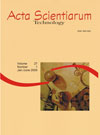Determination of volume duration curve by generalized extreme value distribution to estimate waiting water volume in reservoirs
DOI:
https://doi.org/10.4025/actascitechnol.v29i1.91Keywords:
controle de cheias, eventos extremos, curva volume x duração, momentos LH rios do ParanáAbstract
In the reservoirs of multiple uses of water, exist conflict to control floods, mainly for generation of electric energy. To control floods it's necessary an empty volume able to absorb an accidental flood without causing damage in the areas downstream. On the other side, to generate energy it's desirable to place the smallest volume of possible protection, whereas to control floods it's desirable to have a reliable estimate in case the reservoir fails when a given volume of protection is placed. The objective of this work was to construct the Volume Curve x Length, used to estimate the waiting volume, through the adjustments of the series of the affluent maximum volume using the distribution GEV and moments LH. Affluent volumes were used and observed in several fluviometrics stations of rivers in Paraná state, Brazil. All the adjustments of affluent maximum volumes were accepted through quality tests of proposed adjustments by Wang (1998). The volume curve x length was built properly using values of affluent maximum volumes observed in different fluviometrics stations.Downloads
Download data is not yet available.
Downloads
Published
2007-12-18
How to Cite
Preti, A. P., Queiroz, M. M. F. de, Gomes, B. M., Boas, M. A. V., Fazolo, A., & Silva, V. R. da. (2007). Determination of volume duration curve by generalized extreme value distribution to estimate waiting water volume in reservoirs. Acta Scientiarum. Technology, 29(1), 69–77. https://doi.org/10.4025/actascitechnol.v29i1.91
Issue
Section
Civil Engineering
License
DECLARATION OF ORIGINALITY AND COPYRIGHTS
I Declare that current article is original and has not been submitted for publication, in part or in whole, to any other national or international journal.
The copyrights belong exclusively to the authors. Published content is licensed under Creative Commons Attribution 4.0 (CC BY 4.0) guidelines, which allows sharing (copy and distribution of the material in any medium or format) and adaptation (remix, transform, and build upon the material) for any purpose, even commercially, under the terms of attribution.
Read this link for further information on how to use CC BY 4.0 properly.
0.8
2019CiteScore
36th percentile
Powered by 



0.8
2019CiteScore
36th percentile
Powered by 

















8.png)




